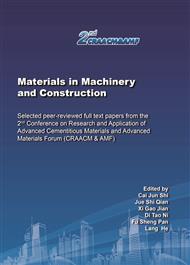p.168
p.175
p.185
p.199
p.208
p.214
p.223
p.230
p.240
Secondary Sintering Cement Clinker in SO2 Atmosphere: Composition and Structure Effects
Abstract:
A gas-solid reaction method was adopted in this work to explore the influence of SO2 gas on the composition and structure of secondary sintering cement clinker. In this process, the Portland cement clinker was secondarily sintered at different temperatures and a mixed gas mixed with SO2 was introduced simultaneously in a tube furnace. X-ray powder diffraction (XRD) combined with rietveld refinement was used to determine the phase composition of the cement clinker and the corresponding phase content. The experimental results showed that the increase in temperature conduced to increasing the content of SO3 solid solution, C2S and CaO, but decreasing the C3S content. Moreover, as the ratio of SO3/MgO (by mass) increases, the content of M1-type alite also increased. And the result of hydration heat release was positively correlated with the content of alite in the clinker. If the content of alite was low, the heat flow was low, as well as the cumulative heat, and vice versa.
Info:
Periodical:
Pages:
208-213
Citation:
Online since:
June 2021
Authors:
Keywords:
Price:
Сopyright:
© 2021 Trans Tech Publications Ltd. All Rights Reserved
Share:
Citation:


